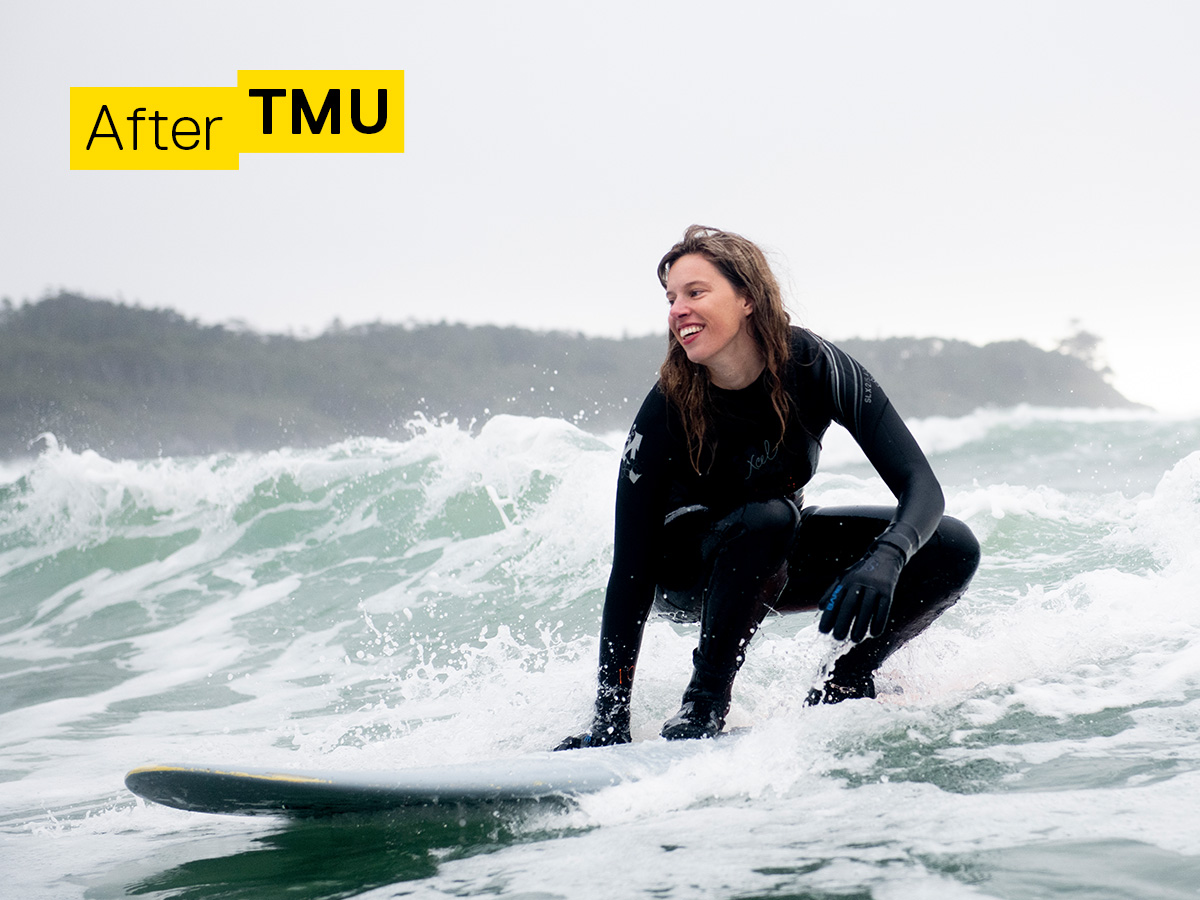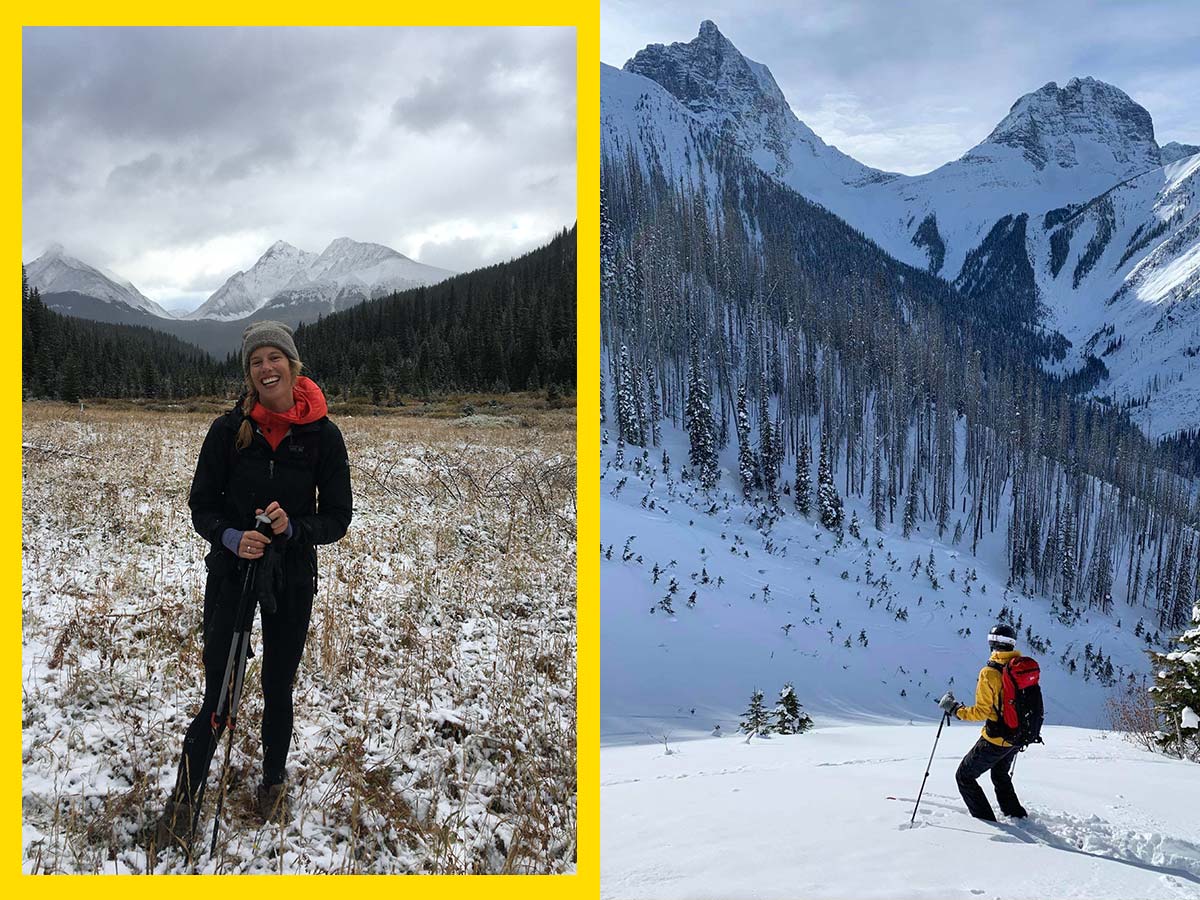After TMU – Alison Hull

Alison Hull
Fashion Design ‘13
Designer - Mountain at Helly Hansen
Alison Hull is an apparel designer with a love for the outdoors! So much love, she’s been designing clothing for outdoor adventurers for some big brands since she graduated. You may actually own some of her creations!
Why did you choose to study at Ryerson University?
I chose to study at TMU for the reputation that the Fashion Design program has. I was fortunate enough to meet a designer who was also a fashion professor at TMU. I was able to talk with her about the program before I even applied. Having both the hands-on learning and the more ‘traditional’ essay style learning was a major attraction to TMU.
What are some skills you developed through university that have benefited you in your career?
Work ethic is massive. The fashion program is difficult to get through, it’s a ton of work and gives you a tough skin to survive in the industry. Textiles is really useful particularly in the technical apparel industry, I reference my notes and textbook to this day. TMU's Fashion program is unique in that it gives you both the hands on skills like pattern drafting, draping, garment construction etc. but it also prepares you for having to do presentations, drafting emails, writing, and data entry. Having garment construction and draping knowledge is really valuable. I don’t sit down and sew very much anymore, but I do have to know how pattern pieces come together, what seams or lines are going to be more difficult for the seam tape machine operator to execute. At the end of the day being able to clearly communicate your idea verbally or visually is extremely useful especially when working with people who don’t speak the same language as you.
How did your experience at TMU help you find your first position after graduation?
TMU helped me get the internship opportunities that then helped me get my first job. It’s a small industry especially within the outdoor and active wear section. Using the connections that TMU has with large companies helped me to land a few internships during school. I attended a number of the meet and greets that were put on for graduating students and then asked about internship opportunities in 2nd and 3rd year. Doing this helped me get a summer internship at the Lululemon Lab in Vancouver. Having TMU’s reputation really helped when applying for both internships and jobs. I got an internship at MEC specifically because one of the designers went to TMU and understood the work ethic that comes out of the program. Having a few recognizable brands as internships really helped me to get my first design position. It’s a very competitive industry, be persistent and don’t be afraid to go to the hiring fairs for graduates. Ask about internship programs or reach out to people who work in the industry and start making those connections.
How has your passion for the outdoors inspired your designs and the way your clothing is created?
I live and breathe the outdoors, just about every aspect of my designs are translated from nature or an experience. I’m usually backcountry skiing, or cross country skiing in the winter, then mountain biking, surfing or hiking in the summers. Doing a variety of outdoor sports has had a huge impact on the success of my designs. A basic understanding of what to pack on a multiday hike or layering for a day of whitewater kayaking is critical to creating functional products. I like to use backcountry skiing as an example. It’s a high risk activity where your gear really needs to work and perform. You’ve got to consider thermal regulation, where are they putting their safety equipment, can the zippers be opened while wearing gloves. Where are the end consumers going, are they skiing deep powder in BC or doing mountaineering in the Rockies? All of these need to be addressed to make the best possible apparel. Of course, not everything I work on is extremely technical; there is lots of opportunity for playfulness. I’ve used pictures from different outdoor trips and turned them into graphics tees, or created prints from patterns you might find on tree bark, or water ripples.

In your experience, what are some attributes or qualities of individuals who are most successful in your field?
Curiosity, and creative problem solving are the first things that come to mind. So much of the outdoors and technical apparel industry is about finding a solution to problems. Whether the end user knows it’s an issue or not. I think successful designers are those that work closely with their counterparts whether it is pattern drafters, product developers or fit specialists. Being able to work as a team is extremely valuable and makes a better product.
You've worked for some big brands! What products or achievements are you most proud of?
Oh, that is a difficult question! Usually my favorites are the ones that are the most challenging to figure out. One that really stands out for me is a women’s whitewater kayaking drysuit for Level Six. The challenge was figuring out zipper placement that wouldn’t rub or dig into your back or thigh when sitting in your boat. This particular project was really special for me. I got to work with female athletes that are extremely passionate about kayaking and are all around badass ladies, who had been wearing men’s suits because there were so few options available for women in the market. I spent quite a bit of time asking what they wanted in a suit, then figuring out how to make that happen. When the product was launched it was super fun to see women out on the water in a suit that was specially built for their needs. In general I love seeing my designs worn and well loved.
What advice would you give students or recent graduates entering the fashion design industry? (outdoor, specifically?)
Be open to other opportunities. I was actually hired as sales staff before getting to move over to design at Level Six. Don’t be afraid to take a job in a role that isn’t design right off the bat. If your values align with the company you might have a better chance of making a switch once you’re in the company. In the long run I feel like a much better designer having worked in a few different roles. Knowing how the different roles work and what the expectations are. Each department has their own goals that they need to hit, knowing their side makes you compassionate and understand why they might be asking for a specific design or design feature. Be open to different roles and companies you never know where they will lead. Keep applying for jobs with companies that sound interesting even if you don’t get them. The more your name gets out there the more connections you’ll make and the easier it will become.
If you could start all over again, would you change your career path in any way? Why?
Call me a bit of a hippie but I think every small or big step leads you on a path that isn’t what you envisioned for yourself at the start of school. When I started at TMU I wanted to be a dress designer and move to Paris, or New York City. I was high fashion obsessed. Now, I’m moving to Norway to work for Helly Hansen. I spend all my time hanging around obsessive outdoors people and panic when I need to get dressed up for something. That is the beauty of university, TMU gives you lots of opportunities to find an area within the industry that you really enjoy. So as a long answer, I wouldn’t change anything but I would try to enjoy the process of discovery without the pressure of feeling like I need to fit into an identity or know the exact area of design.
What are the best parts of your work; what are the necessary evils?
There are lots of great parts of my job. I get to work with world class athletes, mountain guides and Search and Rescue teams around the world to create products. The outdoor industry is unique in that most people who work in it are also very active in the outdoors. I’ve been lucky enough to travel internationally for product testing, photo shoots, factory visits, inspirational trips and product research. On these trips we usually try to combine it with a fun activity as a team. I've gone surfing in Mexico, hiking in Hong Kong, paddle boarding in Utah, and skiing in Revelstoke, to name a few. Travel is always super fun but it’s not a huge part of the job.
The start of a new season is my favorite time. Doing concept work, creating overarching themes, colour palettes and trend research are what I really love to do. My least favorite part is anything that involves a spreadsheet or data entry, and don’t be fooled, in big companies there is a lot of data entry. I think everyone has this idea that as a designer you get to travel the world and sketch products, but in reality that is a very small portion of the job, it’s a lot more data entry than I ever thought.
Anything else you'd like to add, or a favourite TMU memory you'd like to share?
One of my favorite TMU memories I think really sums up how unqiue TMU is. I think it was my second year when a few of my film friends were working on a short film and needed help making a hang glider, (yes you read that correctly). They asked for my help with the sewing. The afternoon was spent working on the dimensions, while another friend was creating the music for the film, someone else was working on the photography and I was sewing a sail. We were able to get this massive hang glider made for this film. Unfortunately, I wasn’t able to go on the filming day but as you’ve probably guessed the hang glider didn’t really fly. I think they might have gotten it 2ft off the ground. But, it was so much fun working on it. I know I have mentioned it earlier but you just never know where you are going to end up and who’s help you might need one day. So stay curious about what others are working on, whether it’s at school, at your office or maybe someone has a really cool passion project, they are often the most fun!
Connect with Alison online:
Instagram: @ali.or.not (external link, opens in new window)
LinkedIn: linkedin.com/in/alison-hull-3b04a720/ (external link, opens in new window)